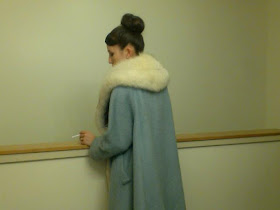In the meantime, I have a bunch of finished projects that need to be shared! Mostly Teslacon and a couple things I made in October. The theme for Teslacon this year was Wild West, and I was really inspired by Annie Oakley's cute outfits and others like hers. Short skirts, fringe, etc. I came up with "Steampunk vivandiere goes West" as one of my outfits. It's made from teal wool from Burnley and Trowbridge with hand-cut deerskin fringe. The outfit consists of an underskirt, overskirt, Swiss waist, blouse, and jacket. I actually thrifted the blouse because... why not! It was perfect for the outfit and saved me a lot of time. Plus it goes perfectly with a 1940s Western outfit that's been sitting in my closet for a couple years. I was going for an 1860s silhouette, and I think it turned out okay. I cut down an old cage crinoline but I'm not completely happy with the shape. Starting a cage from scratch would have been better but I just didn't have time! This was the first outfit that I could really have fun accessorizing. It just begged for goggles, and for once, goggles seemed totally appropriate! It's very sandy in the West, you know. ;-) I also got an old ammo container and I snagged Michael's hat. Michael Steampunk'd my barrel, which was just awesome and got so many compliments. He's so creative! It really lights up!


 a
a


























































